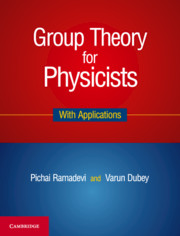Preface
Published online by Cambridge University Press: 08 October 2019
Summary
This text grew out of the group theory lectures taught by the first author to undergraduate students at IIT Bombay. While most students attending the course were majoring in physics, there were also students from electrical, mechanical and aerospace engineering streams. The continued interest of students in the topic motivated us to compile the contents into a textbook suitable for a course pitched at the undergraduate level. We also hope that the text will be useful to researchers who wish to familiarize themselves with the basic principles and typical examples of applications of group theory in physics.
In our day-to-day life as well as in the laboratories, we observe patterns with symmetry. These could be in the symmetric shape of the wings of a butterfly, the arrangement of atoms in a molecule, the shape of nuclei as inferred by advanced experimental techniques, among many others. Group theory is a mathematical formulation of such symmetries. While group theory is of interest in mathematics, the prevalence of symmetries in the physical world enable it to find applications in several other disciplines. For instance, the synthesis of molecules in chemistry, crystallographic structures in physics, elasticity properties in continuum mechanics, etc., require the basics of the symmetry principles.
Understanding complex physical systems in nature by solving complicated mathematical equations can be a daunting task. Group theory offers an elegant and powerful framework to extract certain details about such complex systems. For example, the underlying group symmetry can assert whether a given scattering or decay process is allowed or forbidden without performing any explicit computation. This book employs solved examples as well as a variety of exercises (sometimes drawn from sources listed in the Bibliography) to help the reader appreciate the role of group theory in explaining certain experimental observations. We have tried to balance between the formal mathematical aspects and the applications so that the student can effortlessly absorb the group theory arguments behind ad hoc postulates and selection rules. The contents and presentation style enable undergraduate students to connect with the physics they have learned, or will be learning in courses like quantum mechanics, continuum mechanics, atomic and molecular physics, condensed matter physics, nuclear physics, and particle physics in their undergraduate curriculum.
- Type
- Chapter
- Information
- Group Theory for PhysicistsWith Applications, pp. xiii - xivPublisher: Cambridge University PressPrint publication year: 2019



